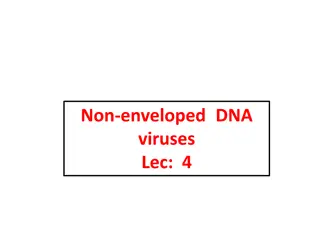Understanding the Transmission of Viruses: Routes and Implications
Viruses are intracellular parasites that require transmission to a new host to evade immune responses. This transmission process, whether through respiratory droplets, fecal-oral routes, or sexual contact, is crucial in the viral life cycle. Different modes of transmission, such as horizontal and vertical transmission, highlight the complex ways viruses can spread, impacting global health. Awareness of these transmission routes is essential in controlling outbreaks and preventing infections.
Download Presentation

Please find below an Image/Link to download the presentation.
The content on the website is provided AS IS for your information and personal use only. It may not be sold, licensed, or shared on other websites without obtaining consent from the author. Download presentation by click this link. If you encounter any issues during the download, it is possible that the publisher has removed the file from their server.
E N D
Presentation Transcript
Transmission Of viruses
Viruses are intracellular parasites and have to find a new host before the original host mounts an effective immune response. The process of transfer of virus into host is referred as TRANSMISSION and this is an important step in the life cycle of viruses. Person to person infections are said to be HORIZONTAL TRANSMISSION, while those from mother to baby are put in a separate category that is VERTICAL TRANSMISSION. ZOONOSES - infection where the virus is transmitted from animal other than humans, to humans.
HORIZONTAL TRANSMISSION
Transmission via the respiratory tract Many virus infection are contracted via the respiratory tract. After virus has multiplied, it either infects additional cells within the same host or escape from the respiratory tract in liquid droplet that result from our normal activities such as coughing, sneezing, and talking. These aerosols are inhaled by others and give rise to a droplet infection . The size of aerosols is important, as those of very large diameter that is greater than 10 m rapidly fall to the ground, while the very small droplets less than 0.3 m dry very quickly, and virus contained within them is inactivated. Thus the middle sized range of droplets are those that transmit infection more efficiently. The medium sized droplets get as far as the trachea, while the smallest droplets penetrate deep into the lung.
The increase in nasal secretion and coughing and sneezing increases the production of infectious aerosols. Example- Common Cold, Influenza.
Transmission via the fecal-oral route Many viruses are ingested with the food and water that is contaminated with feces and infect and multiply in cells of the alimentary tract. This is the fecal- oral route of infection. The surface of the small intestine normally functions to adsorb nutrients and water and can potentially be infected by viruses. All viruses transmitted via the fecal-oral route are excreted in feces, so their spread is favored by poor sanitation and poor personal hygiene. Examples:- Polio virus infections traditionally result from ingesting sewage-contaminated drinking water, but more recently have come from ingesting the water of swimming pools. Hepatitis A virus is commonly experienced by travellers as a result of encounters with drinking sewage-contaminated water.
Sexual Transmission Only a few viruses are spread by sexual transmission but, for them ,it is a very successful route indeed. These viruses are transmitted by heterosexual intercourse, both from male to female and from female to male and homosexual intercourse. The main example are HIV-1 and hepatitis B virus (HBV).
Transmission via urine Transmission of viruses in urine is a rare as urine is always sterile. Virus are excreted in the urine of their hosts and are thought to be transmitted in this way. These viruses infect wild mice. Infected urine can then contaminate surfaces where food is prepared and virus is ingested. Example:- Lassa fever virus
Transmission by mechanical means Animal viruses transmitted by mechanical means include those which directly puncture the normally impermeable skin layer. This route involves the role of virus vectors-animals that transmit the virus to man. Viruses spread by arthropods are known as arboviruses. Viruse that are spread by mosquitoes belong to the alpha-,flavi-,reo-,rhabdo-,and buniyavirus groups.
VERTICAL TRANSMISSION Vertical transmission is the transfer of virus from mother to fetus/baby. The virus can cross the placenta and multiply in the fetus. As a result the fetus can die or can be born with serious problems in eyes , hearing and central nervous system. Example:- Rubella virus, HSV
ZOONOSES A zoonoses is an infection that occurs when virus is transmitted from an animal other than a human, to a human. The common host is another vertebrates and the human is only infected accidently. Biting is a well known zoonotic transmission. Example:- Rabies, Malaria, Dengue, Yellow fever.























